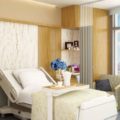According to the U.S. Department of Energy, lighting accounts for over 10% of a hospital’s energy consumption. There is huge potential to improve efficiency and cut costs by changing a hospital’s lighting system to LED light bulbs.
A growing number of hospitals all over the world are investing in energy efficient lighting – and reaping the benefits. The main hall and reception area of Coltman Street Day Hospital in Hull has been transformed with LED lighting. Several hospitals in the United States, including New York-Presbyterian Hospital and St. Mary’s Hospital in Maryland, are leading the way with energy efficient lighting practices.
As well as increasing efficiency, improving lighting levels and enhancing the hospital experience for both staff and patients, LED lights will improve cash flow, and cut down on maintenance and downtime costs.
Every hospital department can benefit from LED light bulbs, including MRI facilities, which require nonferrous lights to ensure the equipment is not affected by magnetic fields. While incandescent bulbs are affected by the high magnetic field within an MRI facility and need to be replaced regularly, LED light bulbs remain largely unaffected.
Operating and examination room lights must be high quality without generating high temperatures, which could dry out body tissue. LED lights are perfect for this purpose. They improve the working environment for the surgeons and increase safety for the patients, while cutting down on air conditioning – another way to cut costs.
Dimmable LED light bulbs are ideal for CT scan and ultrasound rooms, where patient comfort and enhanced observation are crucial.
Switching to LED lights prevents unnecessary mercury exposure – yet another reason to opt for LED light bulbs over incandescent bulbs and fluorescent lighting in a healthcare setting.
Lights in the hallways and communal areas of a hospital are never switched off, so the most cost effective, energy efficient system is desirable. LED lights deliver the best return on the initial investment.
The future looks bright for LED light bulbs within the hospital setting. Trials at Glasgow Royal Infirmary have shown a lighting system using LED technology to be successful in destroying bacteria, including the MRSA superbug. By using high intensity narrow-spectrum light to disinfect the air and exposed surfaces, around 60% more bacteria was killed than cleaning alone. That makes LED light bulbs good news for patients as well as the hospital budget and the environment!
Date: September 26, 2011
Tags: led LED Lighting Lighting studies technology
LED lights offer hospitals an energy efficient lighting solution to improve lighting levels and enhance patient and staff experience.




